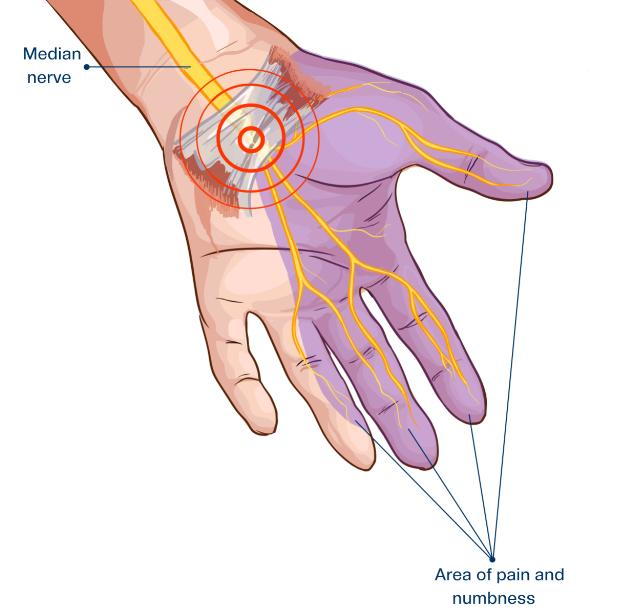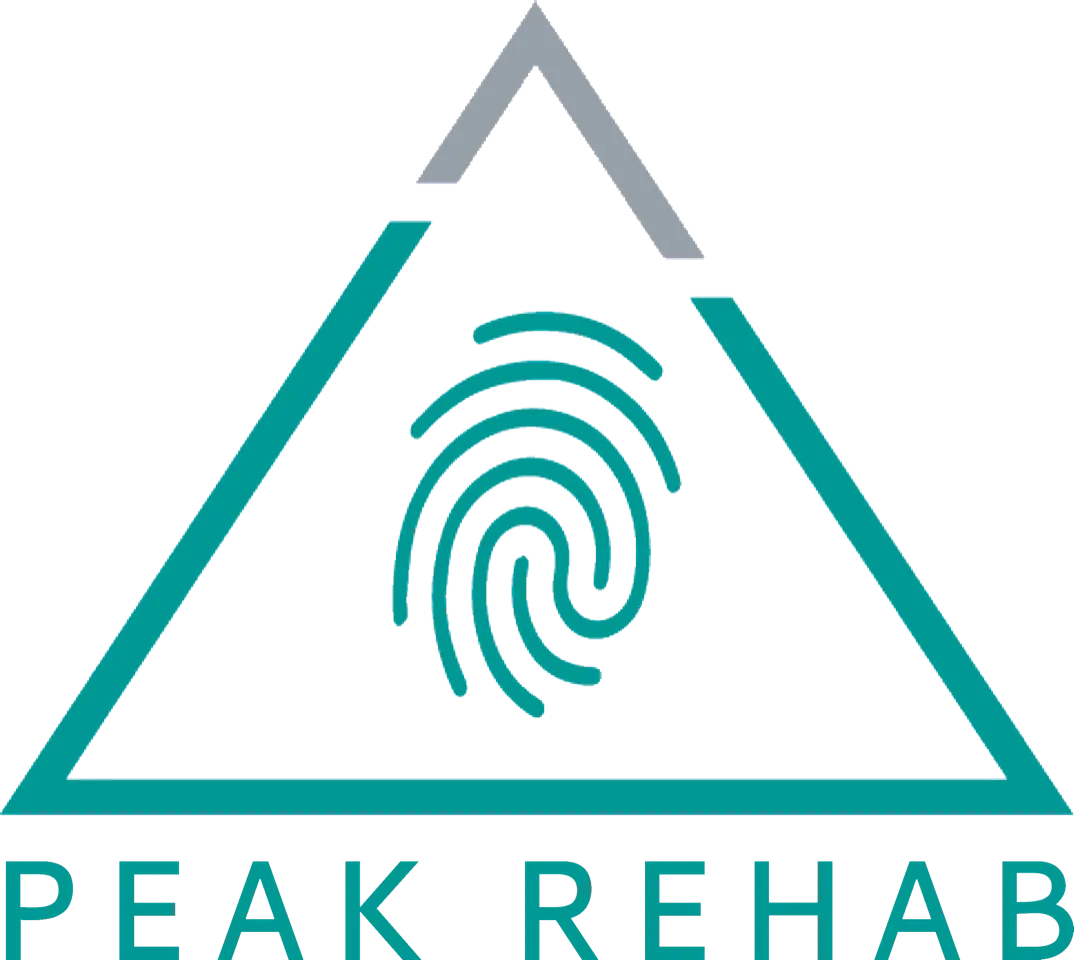What is Carpal Tunnel Syndrome?

What is Carpal Tunnel Syndrome?
Carpal tunnel syndrome (CTS) is a common condition of the wrist and hand that is caused by repeated pressure on the median nerve which is at the base of the palm .It is the most common nerve entrapment neuropathy, accounting for 90% of all neuropathies. Surgery for this condition is commonly performed on the wrist and hand. Fortunately for most people who develop CTS, physiotherapy treatment can often relieve pain and numbness and restore normal use of the hand, wrist, and arm without the need for surgery.
The carpal tunnel is a narrow tunnel on the palm side of your wrist. The tunnel protects the median nerve and the tendons that bend your fingers..It is a condition that causes numbness, tingling, or weakness in your hand.It happens because of pressure on your median nerve, which runs the length of your arm, goes through a passage in your wrist called the carpal tunnel, and ends in your hand. The median nerve controls the movement and feeling of your thumb and the movement of all your fingers except your pinky.
Anything that squeezes or irritates the median nerve in the carpal tunnel space may lead to carpal tunnel syndrome. A wrist fracture can narrow the carpal tunnel and irritate the nerve, as can the swelling and inflammation caused by rheumatoid arthritis. Extreme wrist positions, as well as a lot of finger use, especially with a lot of force or vibration (such as holding the steering wheel when driving heavy machinery), can all contribute to CTS.
Many times, there is no single cause of carpal tunnel syndrome. It may be that a combination of risk factors contributes to the development of the condition.

Risk factors
A number of factors have been associated with carpal tunnel syndrome. Although they may not directly cause carpal tunnel syndrome, they may increase the risk of irritation or damage to the median nerve. These include:
Anatomic factors. A wrist fracture or dislocation, or arthritis that deforms the small bones in the wrist, can alter the space within the carpal tunnel and put pressure on the median nerve.
Sex. Women are three times more likely than men to get it. This might be because they tend to have smaller carpal tunnels.
Nerve-damaging conditions. Some chronic illnesses, such as diabetes, increase your risk of nerve damage, including damage to your median nerve.
Inflammatory conditions. Rheumatoid arthritis and other conditions that have an inflammatory component can affect the lining and cause swelling around the tendons in your wrist and put pressure on your median nerve.
Medications.Certain medicine use (eg, steroids)
Obesity. Being obese is a risk factor for carpal tunnel syndrome.
Pregnancy. Fluid retention may increase the pressure within your carpal tunnel, irritating the median nerve. This is common during pregnancy.
Workplace factors. Have a job in which you make the same motions with your arm, hand, or wrist over and over, such as an assembly line worker, sewer or knitter, baker, cashier, hairstylist, or musician
Signs and Symptoms
CTS symptoms usually start out gradually, with burning, numbness, tingling, pins and needles or pain. You might feel it in your palm, thumb and any of your fingers, but not your pinkie. Often the symptoms are more noticeable during the night, and individuals often report being woken with symptoms. Many people feel the need to "shake out" their hands to try to relieve the symptoms.
As the condition progresses, the symptoms are noticed during the daytime and are often worse when holding items such as a heavy book or a hairbrush. Weakness of the hand and more constant numbness may occur if the pressure on the nerve continues. You may find that you drop objects unexpectedly or have a weakness in your grip.
Diagnosis
Physical therapists work closely with other health care professionals to accurately diagnose and treat CTS. Your physical therapist or doctor may ask you questions and conduct one or more of the following tests to determine whether you have carpal tunnel syndrome: These are several tests that may be used to help diagnose CTS:
Examination of your neck and entire upper extremity to rule out other conditions. Many patients have been told they have CTS, only to find out that the pain is coming from another body area.
Grip strength of fingers and thumb
Sensory tests
Wrist and hand range-of-motion
Wrist flexion (Phalen) test: Your physical therapist will have you push the backs of your hands together for 1 minute. Tingling or numbness in your fingers that occurs within 60 seconds may be an indication of CTS.
Tinel's Sign: Your physical therapist will use a reflex hammer or finger to tap over the median nerve at your wrist. Tingling in the thumb and index and middle fingers may indicate CTS.
Electrical studies (electromyogram/EMG) and nerve conduction velocity (NCV): These tests determine the transmission of the nerve and the severity of the CTS.
X-rays: Some doctors recommend an X-ray of the affected wrist to exclude other causes of wrist pain, such as arthritis or a fracture. However, X-rays are not helpful in making a diagnosis of carpal tunnel syndrome.
In some cases, your physical therapist may refer you to a physician or other health care professional for additional testing or treatment.
PHYSIOTHERAPY TREATMENT
After the evaluation, your physical therapist will prescribe your treatment plan based on your specific case.
Conservative Care
If your evaluation confirms early-stage CTS, conservative care will be recommended as a first step. Physical therapy treatment can be effective in reducing your symptoms and getting you back to performing normal activities. Depending upon the causes of your CTS, your therapy program may include:
Education regarding:
changing wrist positions (ie, avoiding prolonged bent wrist positions)
proper neck and upper back posture (ie, avoiding forward head or slouching)
safe use of sharp utensils, tools, or other implements, if sensory changes are identified
Rest your hands and wrists as much as possible. Give them a break from things that trigger your symptoms.Exercises to increase the strength of the muscles in your hand, fingers, and forearm
Stretching exercises to improve the flexibility of the wrist, hand, and fingers
Use of heat/cold treatments to relieve pain
Wrist splinting.One of the most helpful treatments to curing carpal tunnel is fitting the patient with a resting or nighttime splint which keeps the wrist in a neutral position. The reason for a splint is that many people get into a position which unknowingly compromises the median nerve during rest.
A worksite visit to assess your work area. For example, if you sit at a desk and work on a computer, it's important for the keyboard to be in proper alignment to help avoid working in a bent wrist position.
Increasing the size of tool and utensil handles by adding extra material for a more comfortable grip. Use only as much force as you need. Don't hold your tools too tightly or pound away at your keyboard.
Anti-vibration gloves or anti-vibration wraps around tool handles, if vibration is a factor at your workplace
Your physical therapist will also consider your home and leisure activities, with recommendations such as wearing gloves to keep the wrist/hands warm and limiting sports that aggravate the condition, such as racquet sports, until symptoms resolve.
The goals of physical therapy are to reduce your symptoms without the need for surgery, to enable you to be as active and functional as possible, and to help you resume your normal work, home, and leisure activities.
Physical Therapy Following Surgery
If surgery is the option chosen, physiotherapy may be part of the post-operative treatment plan as well. The physiotherapist can provide a variety of treatment options to help alleviate pain and hypersensitivity around the scar, keep the scar mobile to prevent further constriction at the site and provide exercises to keep the wrist, hand, and nerves or tendons moving and strong.2 The physiotherapist will continue to offer advice related to splinting and activity modification at work or play during your recovery to prevent symptoms from coming back.
How can carpal tunnel syndrome be prevented?
Carpal tunnel syndrome can be difficult to prevent. The condition can be caused by so many different activities in a person’s daily life that prevention can be challenging. Workstation changes—proper seating, hand and wrist placement—can help decrease some factors that can lead to carpal tunnel syndrome. Other preventative methods include:
Sleeping with your wrists held straight.
Keeping your wrists straight when using tools.
Avoiding flexing (curling) and extending your wrists repeatedly.
Decreasing repetitive/strong grasping with the wrist in a flexed position.
Taking frequent rest breaks from repetitive activities.
Performing conditioning and stretching exercises before and after activities.
Monitoring and properly treating medical conditions linked to carpal tunnel syndrome.

What is Carpal Tunnel Syndrome?
Carpal tunnel syndrome (CTS) is a common condition of the wrist and hand that is caused by repeated pressure on the median nerve which is at the base of the palm .It is the most common nerve entrapment neuropathy, accounting for 90% of all neuropathies. Surgery for this condition is commonly performed on the wrist and hand. Fortunately for most people who develop CTS, physiotherapy treatment can often relieve pain and numbness and restore normal use of the hand, wrist, and arm without the need for surgery.
The carpal tunnel is a narrow tunnel on the palm side of your wrist. The tunnel protects the median nerve and the tendons that bend your fingers..It is a condition that causes numbness, tingling, or weakness in your hand.It happens because of pressure on your median nerve, which runs the length of your arm, goes through a passage in your wrist called the carpal tunnel, and ends in your hand. The median nerve controls the movement and feeling of your thumb and the movement of all your fingers except your pinky.
Anything that squeezes or irritates the median nerve in the carpal tunnel space may lead to carpal tunnel syndrome. A wrist fracture can narrow the carpal tunnel and irritate the nerve, as can the swelling and inflammation caused by rheumatoid arthritis. Extreme wrist positions, as well as a lot of finger use, especially with a lot of force or vibration (such as holding the steering wheel when driving heavy machinery), can all contribute to CTS.
Many times, there is no single cause of carpal tunnel syndrome. It may be that a combination of risk factors contributes to the development of the condition.

Risk factors
A number of factors have been associated with carpal tunnel syndrome. Although they may not directly cause carpal tunnel syndrome, they may increase the risk of irritation or damage to the median nerve. These include:
Anatomic factors. A wrist fracture or dislocation, or arthritis that deforms the small bones in the wrist, can alter the space within the carpal tunnel and put pressure on the median nerve.
Sex. Women are three times more likely than men to get it. This might be because they tend to have smaller carpal tunnels.
Nerve-damaging conditions. Some chronic illnesses, such as diabetes, increase your risk of nerve damage, including damage to your median nerve.
Inflammatory conditions. Rheumatoid arthritis and other conditions that have an inflammatory component can affect the lining and cause swelling around the tendons in your wrist and put pressure on your median nerve.
Medications.Certain medicine use (eg, steroids)
Obesity. Being obese is a risk factor for carpal tunnel syndrome.
Pregnancy. Fluid retention may increase the pressure within your carpal tunnel, irritating the median nerve. This is common during pregnancy.
Workplace factors. Have a job in which you make the same motions with your arm, hand, or wrist over and over, such as an assembly line worker, sewer or knitter, baker, cashier, hairstylist, or musician
Signs and Symptoms
CTS symptoms usually start out gradually, with burning, numbness, tingling, pins and needles or pain. You might feel it in your palm, thumb and any of your fingers, but not your pinkie. Often the symptoms are more noticeable during the night, and individuals often report being woken with symptoms. Many people feel the need to "shake out" their hands to try to relieve the symptoms.
As the condition progresses, the symptoms are noticed during the daytime and are often worse when holding items such as a heavy book or a hairbrush. Weakness of the hand and more constant numbness may occur if the pressure on the nerve continues. You may find that you drop objects unexpectedly or have a weakness in your grip.
Diagnosis
Physical therapists work closely with other health care professionals to accurately diagnose and treat CTS. Your physical therapist or doctor may ask you questions and conduct one or more of the following tests to determine whether you have carpal tunnel syndrome: These are several tests that may be used to help diagnose CTS:
Examination of your neck and entire upper extremity to rule out other conditions. Many patients have been told they have CTS, only to find out that the pain is coming from another body area.
Grip strength of fingers and thumb
Sensory tests
Wrist and hand range-of-motion
Wrist flexion (Phalen) test: Your physical therapist will have you push the backs of your hands together for 1 minute. Tingling or numbness in your fingers that occurs within 60 seconds may be an indication of CTS.
Tinel's Sign: Your physical therapist will use a reflex hammer or finger to tap over the median nerve at your wrist. Tingling in the thumb and index and middle fingers may indicate CTS.
Electrical studies (electromyogram/EMG) and nerve conduction velocity (NCV): These tests determine the transmission of the nerve and the severity of the CTS.
X-rays: Some doctors recommend an X-ray of the affected wrist to exclude other causes of wrist pain, such as arthritis or a fracture. However, X-rays are not helpful in making a diagnosis of carpal tunnel syndrome.
In some cases, your physical therapist may refer you to a physician or other health care professional for additional testing or treatment.
PHYSIOTHERAPY TREATMENT
After the evaluation, your physical therapist will prescribe your treatment plan based on your specific case.
Conservative Care
If your evaluation confirms early-stage CTS, conservative care will be recommended as a first step. Physical therapy treatment can be effective in reducing your symptoms and getting you back to performing normal activities. Depending upon the causes of your CTS, your therapy program may include:
Education regarding:
changing wrist positions (ie, avoiding prolonged bent wrist positions)
proper neck and upper back posture (ie, avoiding forward head or slouching)
safe use of sharp utensils, tools, or other implements, if sensory changes are identified
Rest your hands and wrists as much as possible. Give them a break from things that trigger your symptoms.Exercises to increase the strength of the muscles in your hand, fingers, and forearm
Stretching exercises to improve the flexibility of the wrist, hand, and fingers
Use of heat/cold treatments to relieve pain
Wrist splinting.One of the most helpful treatments to curing carpal tunnel is fitting the patient with a resting or nighttime splint which keeps the wrist in a neutral position. The reason for a splint is that many people get into a position which unknowingly compromises the median nerve during rest.
A worksite visit to assess your work area. For example, if you sit at a desk and work on a computer, it's important for the keyboard to be in proper alignment to help avoid working in a bent wrist position.
Increasing the size of tool and utensil handles by adding extra material for a more comfortable grip. Use only as much force as you need. Don't hold your tools too tightly or pound away at your keyboard.
Anti-vibration gloves or anti-vibration wraps around tool handles, if vibration is a factor at your workplace
Your physical therapist will also consider your home and leisure activities, with recommendations such as wearing gloves to keep the wrist/hands warm and limiting sports that aggravate the condition, such as racquet sports, until symptoms resolve.
The goals of physical therapy are to reduce your symptoms without the need for surgery, to enable you to be as active and functional as possible, and to help you resume your normal work, home, and leisure activities.
Physical Therapy Following Surgery
If surgery is the option chosen, physiotherapy may be part of the post-operative treatment plan as well. The physiotherapist can provide a variety of treatment options to help alleviate pain and hypersensitivity around the scar, keep the scar mobile to prevent further constriction at the site and provide exercises to keep the wrist, hand, and nerves or tendons moving and strong.2 The physiotherapist will continue to offer advice related to splinting and activity modification at work or play during your recovery to prevent symptoms from coming back.
How can carpal tunnel syndrome be prevented?
Carpal tunnel syndrome can be difficult to prevent. The condition can be caused by so many different activities in a person’s daily life that prevention can be challenging. Workstation changes—proper seating, hand and wrist placement—can help decrease some factors that can lead to carpal tunnel syndrome. Other preventative methods include:
Sleeping with your wrists held straight.
Keeping your wrists straight when using tools.
Avoiding flexing (curling) and extending your wrists repeatedly.
Decreasing repetitive/strong grasping with the wrist in a flexed position.
Taking frequent rest breaks from repetitive activities.
Performing conditioning and stretching exercises before and after activities.
Monitoring and properly treating medical conditions linked to carpal tunnel syndrome.
Visit our Office
Peak Rehab
2 Kennedy Rd S Suite #4A
Brampton, ON L6W 3E1, Canada
